Chapter 9
Warming Up and Chilling Out: Why Climates Happen
In This Chapter
 Feeling the heat
Feeling the heat
 Tilting along
Tilting along
 Changing seasons
Changing seasons
 Observing current affairs
Observing current affairs
H ave you ever felt people were staring at you in a discreet sort of way? I certainly have. And I can give an example that relates directly to this chapter.
I was in a Swiss village on a sunny and warm July afternoon. The temperature was in the mid-eighties, which is why I was wearing shorts and a short-sleeved shirt. I got on a cable car to go way up into the mountains to take in the view and go for a hike. There were about 20 other people on board, and the higher we went, the more I felt their eyes. So I looked back, and in so doing quickly understood their stares.
Nobody else was dressed like me. Not even close. They had on heavy pants and heavy shirts, with sweaters and jackets at the ready. And for good reason. When we got to the top and the doors opened, a blast of cool air rushed in. Im guessing the temperature was in the high forties. My first reaction was to feel totally stupid. Like, duh, shouldnt a geographer have been prepared for this? My second reaction was to cancel the hike and keep warm until the cable car made the return trip.
That brief journey began and ended on the side of the same mountain under the same sun. But something happened to the air temperature that made all the difference in the world. The same is true globally. You can travel the world and experience all kinds of climates. Together they constitute a vast array of atmospheric characteristics that concern temperature, precipitation, and seasonal change. But no climate just happens. While all are products, directly or indirectly, of the same sun, factors are afoot that give each of them characteristics that really do make all the difference in the world.
The factors that determine climate in different parts of the world are of central interest to geography and are the subjects of this chapter. The characteristics, locations, and consequences of climate occupy the next chapter.
Getting a Grip on Climate
Like climate, weather is concerned with atmospheric conditions. The difference between the two is a matter of time. Weather refers to day-to-day conditions and changes in Earths atmosphere. Climate refers to the average of weather conditions at a location over a long period of time 30 years, as far U.S. government climatologists are concerned. Climate, therefore, is the more appropriate topic for this book because it concerns general characteristics of a location or region. Accordingly, among the things you will not read about here are tornadoes, hurricanes, thunder, lightning, hail, and other forms of short-term atmospheric mayhem that fall within the purview of weather. (For more information on weather, see Weather For Dummies [Hungry Minds, Inc.].)
So what factors cause the different kinds of climates to occur? (Drum roll, please.) Six determinants, which may act singly, in combination, or in opposition to each other, make climate occur:
 The angle at which solar energy strikes the Earth
The angle at which solar energy strikes the Earth
 Tilt of the Earth on its axis
Tilt of the Earth on its axis
 Altitude with respect to sea level
Altitude with respect to sea level
 Solar absorption properties of land and water
Solar absorption properties of land and water
 Ocean currents
Ocean currents
 High and low atmospheric pressure belts
High and low atmospheric pressure belts
The following sections show how each bullet point creates climate.
Playing the Angles
Parts of Earth receive different amounts of solar energy heat from the sun. The dosages are greatest in the equatorial realms and progressively diminish as one approaches the Poles. For this reason, rather warm climates generally dominate the low latitudes and give way to cooler and cooler climates in the mid-latitudes and polar regions.
These differences are due to the angles at which solar energy strikes the Earth at different latitudes. Figure 9-1 shows three bundles of sunshine whose widths are the same, so it can be assumed they contain equal amounts of solar energy. But if you examine the amount of Earth that each impacts, a key difference appears. Bundle A illuminates a much smaller area than Bundle B, which in turn illuminates a much smaller area than Bundle C.
Figure 9-1: Solar energy strikes the Earth at three latitudes. | 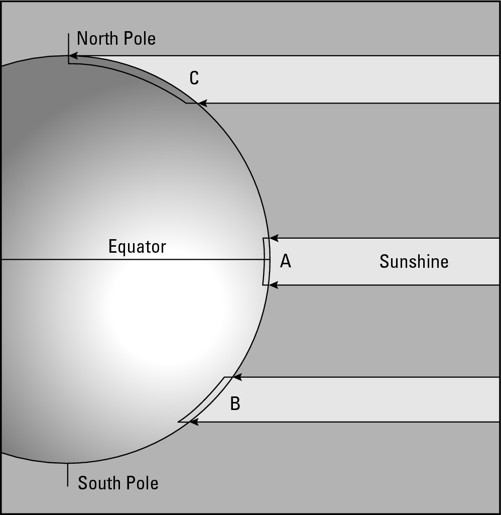 |
Making hot and cold
The differences among the Bundles in Figure 9-1 are determined by the curvature of the Earth. Bundle A contains vertical rays, which strike Earth perpendicularly. Due to curvature, however, Bundle B strikes Earth at a sharper angle. As a result, its solar energy is spread over a larger area than is Bundle As. Sharper still, thanks to curvature, is the angle at which Bundle C strikes Earth. And as a result, its heat is spread over the largest area of the three examples.
Absent other factors that affect temperature, Area A has the warmest climate because it has the greatest concentration of solar energy. That is, the heat in Bundle A is brought to bear on a relatively small area. In contrast, Area C has the coldest climate because the heat it receives is spread over the largest of the three areas. Intermediate conditions are present in Area B.
Lets look at some real locales and compare the climates of Manaus, Brazil, and Churchill, Manitoba (Canada). Manaus is located at about Latitude 3 South and therefore exemplifies Area A on the diagram. Churchill is located at Latitude 58 North and therefore has the characteristics of Area C.
In Manaus, the annual average temperature is 79 F. (That means that if you recorded the temperature every hour of every day for a year, the average would be 79 F). In Churchill, its 19 F. The difference is 60 F. Manaus is much warmer.
Beware the reason! Is it because Manaus is closer to the equator? Nope. Proximity to the equator per se is not the explanation. Instead, the answer lies in the angle. The sun is more directly overhead at Manaus than at Churchill throughout the year. Thus, Manaus experiences a greater concentration of solar energy throughout the year and is therefore a warmer climate.

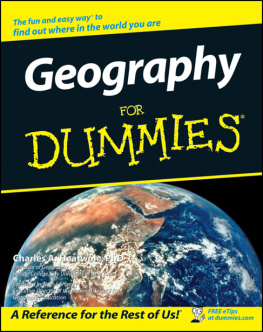

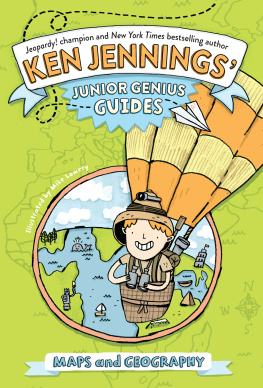

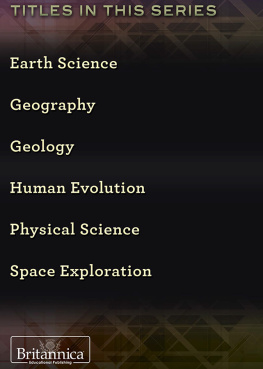



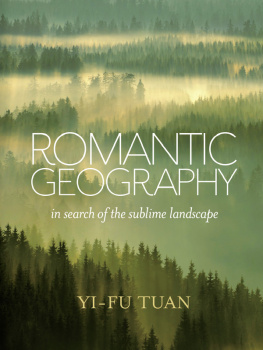
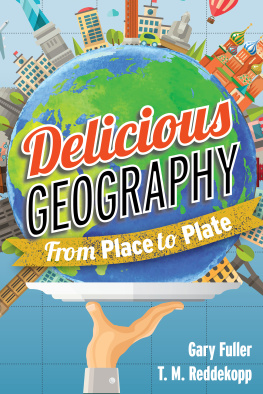

 Feeling the heat
Feeling the heat
.jpg)
 The angle at which solar energy strikes the Earth
The angle at which solar energy strikes the Earth